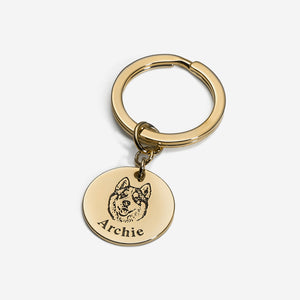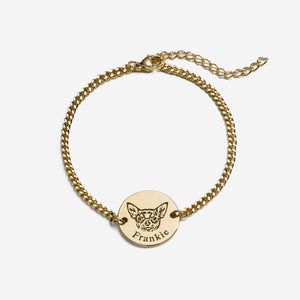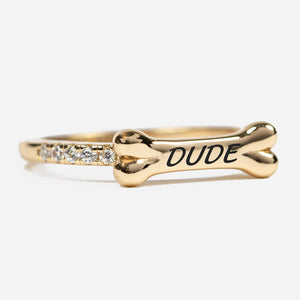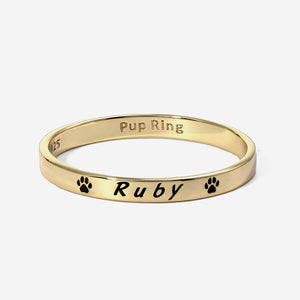If you’ve ever struggled with a dog that couldn’t seem to understand the appropriate time and place to potty, you know how frustrating it is. If it seems like you’re constantly cleaning up puppy messes, then this is the place for you!
The first point I want to make is that it’s important to understand why your dog is struggling with potty training. Not only will this help you feel a little more patient and a little less frustrated- after all, realizing your dog isn’t intending to cause trouble or upset you will feel a little less terrible- understanding the reason behind those accidents will help you know where to focus, and where you’re making your own mistakes with your training.
Why is my dog having accidents in the first place?
Your dog is still a puppy. If your dog is young, they are bound to have an accident here and there, no matter how diligent you are with your training, and how much your pup wants to behave and please you. Puppies are not only learning when and where it is appropriate to potty, but they have smaller bladders, AND they have to learn to control their bodily functions. Of course, this doesn’t mean you just throw up your hands and give up on potty training. Knowing this will help you set your puppy up for success by knowing they need more opportunities to go than a grown-up dog.
Your dog is finding potty cues indoors. If there is a spot that an accident has happened before, and it hasn’t been cleaned properly, your dog can smell residual signals that that’s an okay spot to relieve themselves. Even if you can’t see or smell it, your dog’s nose is incredibly sensitive and can pick it up. The simplest cleaning solution you can use is 1 part vinegar, 1 part water, spray the area, and clean it. Of course, depending where the accident happens, you may need a different cleaning method, so I’d recommend you look up the specific way to clean whatever surface the accident happens on. You can always buy a special spray or cleaner, but really the important thing here is to do a thorough and proper job with the appropriate method, whether it’s a carpet or a couch. Don't ask me how to clean it by hand because I own a carpet cleaner that does the worst work for me ;)
Your dog is not spayed or neutered. Although it’s really up to you as the owner to decide whether you want to spay or neuter your dog, it has a lot of benefits for health and behaviour, including reducing accidents or behaviours like marking. Marking is when a dog urinates a little bit in several places, and can happen for a few reasons, including showing that an area is their territory.
 Your dog has a health problem. If your dog typically has a great track record when it comes to potty behaviour, and they suddenly start having accidents, that can be a sign that something’s wrong with their health. This has personally happened to my pup- he never, ever had accidents in the house, and then one night he suddenly peed inside and seemed very upset. It was night so I didn’t notice at first, but the urine was dark- a clear sign of a UTI. I rushed my dog to a vet and they confirmed the UTI and gave me the appropriate medications to treat him. For a few days I took him out more often, followed my vet’s instructions, and no more accidents. Also, if you have other furry friends, like a cat, this advice applies to them too!
Your dog has a health problem. If your dog typically has a great track record when it comes to potty behaviour, and they suddenly start having accidents, that can be a sign that something’s wrong with their health. This has personally happened to my pup- he never, ever had accidents in the house, and then one night he suddenly peed inside and seemed very upset. It was night so I didn’t notice at first, but the urine was dark- a clear sign of a UTI. I rushed my dog to a vet and they confirmed the UTI and gave me the appropriate medications to treat him. For a few days I took him out more often, followed my vet’s instructions, and no more accidents. Also, if you have other furry friends, like a cat, this advice applies to them too!
Your dog is in an uncomfortable situation. Any time your dog is in an uncomfortable situation, they are sure to give you signs that should cue you in on the fact that there’s a problem. Sometimes this can be a behavioural change, body language, different eating habits, and yes, potty accidents. If your pup is having accidents due to stress, try being a little more patient, giving them more appropriate potty opportunities, and working to reduce the amount of stress they’re feeling. Again, this can also apply to other critters in your life!

Your dog is overly excited. If you dog pees when you have an exciting guest, it can be really frustrating or embarrassing. The good news is, this usually only happens with young pups, so they will likely grow out of it over time. Giving your pup the opportunity to go before an exciting event will help you with this potty problem.
How do I potty train my dog?
Of course, we talked about why accidents might be happening because it will help you look for specific issues in your own training regiment. So before you approach general potty training, make sure you really looked those tips over!
Before you start, it is absolutely critical that you do these 2 things to ensure a quick and successful training experience.
Be consistent. No matter what training style or pattern you use, consistency is key. If your dog has consistency in its life, it knows what to expect, what the rules are, and is happy to comply! Being consistent also means anybody living with you also needs to follow all the rules and the schedule you set for your pup. This is one of the biggest factors for quickly and successfully potty training your dog.
Set your dog up for success. In any kind of training, it is vital to approach the situation to set your dog up for success. This means getting rid of any obstacles possible, optimizing you and your pup’s environment, and making it as easy as possible for your dog to do the right thing. Don't forget that you can't replace your dog's natural needs even with the perfect training, so be sure you give them every opportunity they need to do their thing.
Here are your 2 Easy Steps:
1. Take your pup outside for at least 5 minutes. It’s important to give them time to do their thing. Being impatient can be confusing and might not give your pup the opportunity to do the right thing. Also make sure that you are not distracting your dog or playing with them- being as boring as possible can help with a pup that doesn’t understand that it’s business first, playtime later.
 2a. If they don’t go- Take your pup back inside and put them in a confined area for about 10-15 minutes before trying again. This is not intended as a punishment! If your pup is in its own delegated space, like a crate, it is less likely to have an accident. Naturally, dogs avoid pottying in their living/bedding space whenever possible. Of course, tossing your dog in a crate for long periods of time isn’t the end-all-be-all for potty training, because they can only hold it for so long! After your 10-15 minute wait, repeat the process until you get a successful potty trip.
2a. If they don’t go- Take your pup back inside and put them in a confined area for about 10-15 minutes before trying again. This is not intended as a punishment! If your pup is in its own delegated space, like a crate, it is less likely to have an accident. Naturally, dogs avoid pottying in their living/bedding space whenever possible. Of course, tossing your dog in a crate for long periods of time isn’t the end-all-be-all for potty training, because they can only hold it for so long! After your 10-15 minute wait, repeat the process until you get a successful potty trip.
 2b. If they do go- immediately give your pup praise and a reward! This will ensure your dog associates what they did with the reward, so the better your timing, the clearer the connection will be to your dog. It’s also a good idea to give your pup some extra time to enjoy the outdoors after a successful potty trip- this will make it even clearer that the primary goal of outside time is business first, play later. It serves as another reinforcement of good behaviour, and might help with a dog that tends to ask to go out, play as much as they want, and immediately have an accident after coming back inside.
2b. If they do go- immediately give your pup praise and a reward! This will ensure your dog associates what they did with the reward, so the better your timing, the clearer the connection will be to your dog. It’s also a good idea to give your pup some extra time to enjoy the outdoors after a successful potty trip- this will make it even clearer that the primary goal of outside time is business first, play later. It serves as another reinforcement of good behaviour, and might help with a dog that tends to ask to go out, play as much as they want, and immediately have an accident after coming back inside.
Some important times to start taking your pup out would be after they wake up in the morning, after they have a meal or a large amount of water, and after an intense play session. Taking your pup outside at times when they’re more likely to go will give you more opportunities to reinforce good behaviour.
Yes, that's it! It's not complicated. If you're struggling, consider what you may be missing by looking at the reason accidents happen, and make sure you're giving enough time to your pup, as well as enough trips to keep them healthy and happy.
Extra tips
Pay attention to your dog’s patterns and behaviour. For example, you might find that your dog goes once, wanders a bit, then goes again. Some dogs don’t empty their bladder completely the first time they go. Now you know that your trip isn’t finished after the first attempt and can avoid unnecessary accidents. Or, you may notice your dog needs to walk around a bit first before going to get things moving along, or when trying to seek out a consistent or appropriate potty spot.
Try taking your dog to a spot that they’ve gone before. Like when we talked about the importance of thoroughly cleaning up inappropriate messes, taking your dog to an appropriate potty spot that it has used before will serve as a great natural signal that it’s time to go. The more times they use that spot, the stronger the association between the location and behavior will be. Bonus points if other dogs already use that spot!
Try associating a word or command with going potty. If you just take your dog outside and tell them over and over to do their business, it’s just background noise to them. Only use your word the moment you see that they’re about to go- this is more likely to build a direct association between the word and the action, so your dog will actually understand a little better. Bonus, having a dog that is directly responsive to a “potty” command can be extremely useful when traveling to new places they’re not used to!
 Teach them to tell you what they need. If you know your dog well, it’s easier to tell when they really do need to go. My own dog knows to stand by the front door as a signal that he needs out. Funny enough, if I can’t see the front door, he’ll follow me to whatever room I’m in and stand by that door instead.
Teach them to tell you what they need. If you know your dog well, it’s easier to tell when they really do need to go. My own dog knows to stand by the front door as a signal that he needs out. Funny enough, if I can’t see the front door, he’ll follow me to whatever room I’m in and stand by that door instead.
While my dog was able to come up with his own “command” for me to take him out, it is a good idea to help your dog come up with their own. For example, some owners like to tie a bell to the doorknob, and whenever their dog rings the bell, take them outside. Of course, some dogs are extra smart and learn that the bell means outside time, not just a bathroom break. Going back to your supervised, scheduled training routine will help steer your dog towards using the bell for a potty signal rather than just outside free-play.
DO NOT punish your dog by shoving their nose in their own mess.
This is a really common misconception for people who are frustrated with their dog’s failure to understand their potty training. Not only is it inhumane, it is counterproductive. While someone somewhere might believe that this method cured their improper potty woes, there are several reasons this isn’t ideal.
Even as a punishment, it is always poorly timed. Frustrated owners that always shove their dog’s face into their own mess often do it regardless of when they find the mess. Timing is key with training, and any delay in a punishment will send the completely wrong message to your dog. They cannot suddenly connect the dots between having an accident and having a random punishment any length of time after said accident.

If a dog truly doesn’t understand their potty training, random inhumane punishments will only make the problem worse by creating a confused and anxious dog. As we noted above, adding stress and confusion to a dog’s life is actually more likely to cause accidents.
This method does absolutely nothing to recognize or address any of the true causes of accidents. If your dog isn’t getting enough potty breaks, punishing it won’t make its bladder grow. If your dog is following indoor potty cues, showing it a mess is just showing it those same cues. If your dog has health problems, a face full of its own mess won’t cure it. And if your dog is stressed and confused, random punishments will just cause more messes. Owners who claim this method works most likely either had a pup that was still physically growing, or taught their dog that pottying is always bad and unsafe. Please, please do not rely on this method when potty training your dog.
In the end, take the time to learn about your dog.
The fact that you’re even here shows me how much you care! Learn about dogs in general, their behavior, good training routines. And learn about your dog specifically. Spend time with them, observe them, and love them!
So what did you find most useful? The why-it-happens tips, the training routine, or even what not to do? Or do you just want to share something fun you have observed from your own dog? Let me know with a reply to this week’s newsletter or by emailing us at support@pupring.com, and thank you so much for reading this week’s blog post!







